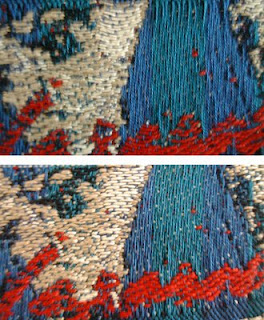I noticed that Alice Schlein has a post today about her beginning weft-backed studies. So it seems timely to post an image of the study I did after I completed Intertwined. Of course it would have made sense to do this study beforehand. You can see that I took the same area of design and repeated it four times. Each section had 208 picks total, and was designed thinking there would be 104 picks per inch (ppi). The bottom strip used the same structures I used in Intertwined. The one above that changed the ground structure to a 12-shaft satin that was not a weft-backed structure. You can see it caused the ppi to decrease, elongating the circle. The third study used weft-backed structures where the back wefts are all tacked by the same warp end, and the ground also tacks this way; and the top study uses the corrected incremental tacking and a variation of this for the ground.

Study to compare structures and picks per inch
The detail below shows an area in the first study at the top and a similar area in the last study at the bottom. The ground structures, which show the blue warp, are different structures, but the only difference in structure in the white/beige area is that the bottom structure had the ties slid over--as I showed in my corrected structure on March 29th. It was clear while weaving that the wefts could pack tighter, and this was proved when I counted ppi. At top the ppi was exactly 104, but the bottom study wove at 111 ppi. I think you can tell also that the wefts at top were moved out of line to adjust to the tacking points that were adjacent (see structures from March 27th post), where they lie smooth and horizontal in the bottom study.
Today I wound the new warp--10/2 tencel, end and end (actually black, white, black, tussah). I use a warping mill and paddle when I make my warps. I have a small mill which I usually use, but today I used my big one since the warp is 14 yards--which is a very long warp for me. Tomorrow I will start tying knots--this warp tied to the old one on the loom. All day I have been fussing about the reed. Right now I have 20/2 tencel on the loom, 2 per dent in a 30 dent reed, but I think I will change it to a 15 dent reed and put 4 ends per dent. I am trying to think if there is some easy way to change reeds, but so far I keep coming back to tie the ends, wind the warp back through the old reed and then redent into the new reed. If you have a better suggestion, please add a comment or send me a personal email.
I was feeling lazy and wound directly from cones to the paddle, so I wound 4 ends at a time. This meant 220 times to get 880 ends. As soon as I began I regretted not doing 8 ends at a time, and I am sure if I did 8, I would have thought I should have done 12. Still one quarter the time was a big saving. I know that paddles can be a bit awkward at first, but once you understand and are comfortable, you never want to return to single ends. I have friends who work with multiple strands and make the cross by hand each time, but really, using the paddle is so much easier. I tried to take a picture to show you (below). It is just like a rigid heddle with eyes and slots. The threads in the eyes stay put and the ones in the slots can move up or down, creating the cross. (Sorry non-weavers, I did title this post "Technical.")
Look what I found out in my front yard!! A sure sign of spring. My neighbor has several flowers in bloom. Such joy to welcome a fresh season.









Hi Bhakti,
ReplyDeleteI loved seeing your process of study. I'm eager to get there and give it a try!
Tommye
Hi Bhakti
ReplyDeleteGotten better from being sick, catching up on reconnections one at a time!
We have daffodils and tulips now, yes, spring is coming. I cant wait to get to New England.
I love watching the technical processes.